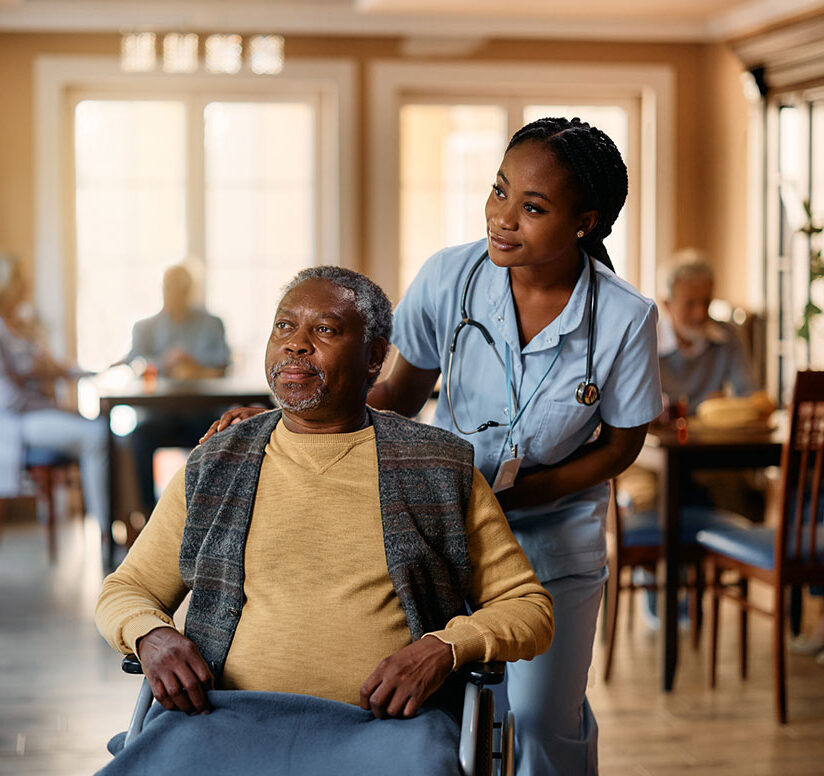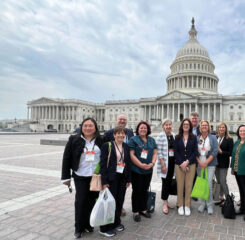CMS Revises Visitation Guidance to Allow More Visitation Options
On September 17, 2020, the Centers for Medicare and Medicaid Services (CMS) released revised visitation guidance for nursing homes during the COVID-19 Public Health Emergency. The Nursing Home Visitation – COVID-19 QSO-20-39-NH provides guidelines, core principles and best practices for nursing home visitation both indoors and outdoors. As nursing homes prepare for either type of visitation, they must continue to adhere to screening protocols for all who enter, practice hand hygiene, wear face coverings or masks, maintain social distancing, wear appropriate PPE, clean and disinfect high touch surfaces and areas, create cohorting of COVID positive residents and comply with CMS regulations for staff and resident testing. In addition, CMS outlines directions for nursing homes to alert visitors as they maneuver through the community, including instructional signage and visitor education on COVID-19, infection control and nursing home policies.
Following a person-centered approach and adhering to Centers for Disease Control and Prevention (CDC) guidance, nursing homes can now accommodate visitors.
Outdoor Visitation
CMS states that outdoor visitation is preferred because there is reduced risk of transmission with increased space and airflow. However, there are hinderances to outdoor visits that a nursing homes must consider including weather conditions, temperature, air quality, and individual resident’s health status. Organizations should create and adapt accessible and safe outdoor spaces for visitation in their communities. CMS states the organization should have a process to limit the number and size of simultaneous visits as well as the number of individuals visiting, all while adhering to safe infection prevention actions.
Indoor Visitation
Nursing homes should accommodate and support indoor visitation based on specific guidelines CMS outlined. First, the nursing home should have NO new onset COVID-19 cases in the last 14 days and not be currently conducting outbreak testing. Second, CMS reiterates that visitors MUST comply with and adhere to the core principles of infection control and staff will need to monitor for any visitor having difficulty adhering. Third, an organization should limit the number of visitors per resident as well as the number of visitors in the building based on size and physical space. Ideas to help limit could be scheduling visits at certain times and days and limiting the length of time to visit. Lastly, organizations must limit the movement of visitors in the facility. A visitor should not walk on neighborhoods or units where they will not be visiting a resident. This is where signage will help visitors move throughout the building. Also, if there is a semi-private room with a roommate, the organization must not conduct the visit in the resident’s room.
CMS also outlined a few other important guidelines for visitation: first, organizations must continue to use the COVID -19 county positivity rate data to determine how to facilitate indoor visitation. Other factors may be monitored to understand the level of COVID-19 risk in the county such as visits to the emergency department or the positivity rate of an adjacent county to the nursing home. NOTE: county positivity rate does NOT need to be considered for outdoor visitation.
Visitors are NOT required to be tested to visit residents, however, CMS is encouraging organizations in medium or high – positivity counties to test visitors if feasible. Visitors, may be tested two to three days before visiting and bring proof of the test date and negative results.
Compassionate Care and Ombudsman Visits
CMS has defined compassionate care visits as situations that are not exclusively end-of-life situations. Examples of other types may be a resident living with family before being admitted and struggling in their new environment, a resident grieving from a friend or family’s death, a resident who needs cueing or encouragement with meals and had this previously provided by a family member or caregiver and possibly, a resident who is experiencing emotional distress or lack of interaction that they previously did not experience. These examples would be consistent with the intent of visits for compassionate care situations and may be conducted by clergy or lay persons as well as family members. Lastly, these visits should be conducted with social distancing but if there is an appropriate way using infection prevention guidelines, personal contact can be allowed.
CMS restated guidance that requires nursing homes to provide immediate access to representatives of the Office of the State Long-Term Care Ombudsman program. In addition, the Ombudsman is allowed to have immediate access to examine the resident’s medical, social and administration record as authorized by State law. In addition, CMS reminds organizations to comply with the federal disability rights laws and Protection and Advocacy (P&A) Programs, to protect the rights of individuals with developmental and other disabilities. Representatives of the P&A program are permitted access to all facility residents. Nursing homes also must comply with federal disability rights laws to require assistance to ensure effective communication can be provided to the resident. The organization must allow the individual entry if the assistance is not available by onsite staff or offsite video interpreting.
Organizations may not restrict visitation if there have been no COVID-19 cases in the last 14 days and their county positivity rate is low or medium. Nursing homes must facilitate in-person visitation consistent with the regulations and the guidelines stated. A failure to facilitate visitation without adequate reason related to clinical necessity or resident safety could face a potential violation of 42 CFR 483.10(f)(4).
Communal Activities and Dining
Each organization must determine whether to allow communal activities and dining based on the status of COVID-19 infections in the facility. Using the core principles of COVID-19 infection prevention, residents may eat in the same room with social distancing and limiting the number of people at a table with six feet between each person. For activities in a group, social distancing, hand hygiene and face coverings must be observed for all activities.
Survey Considerations
There are no new federal citations for non-compliance in this MEMO for indoor or outdoor visitation compliance. However, CMS has outlined current federal regulations that may be cited if a nursing home restricts access to visits, limits visits without a reasonable clinical and safety cause, denies ombudsman access to the resident or the resident’s medical record, and not adhering to infection control practices. Surveyors may cite any of these instances for non-compliance.
As a help to nursing homes, CMS is opening the application of CMP funds to facilitate visitation and in-person visits. Nursing homes may apply to use up to $3,000 per facility in CMP funds to purchase outdoor tents or Plexiglas to create physical barriers to reduce any transmission risk. Each nursing home must ensure that any tent installation meets life safety code requirements. This new CMP allotment is in addition to the technology support CMS previously allowed for nursing homes to apply earlier in the pandemic.

Most Recommended
February 29, 2024
Say Yes to Lobby Day!
April 05, 2024
Cyberattack Updates: Change Healthcare Payment Platform
March 27, 2024
 Colleagues on the Move, March 27, 2024
Colleagues on the Move, March 27, 2024
April 12, 2024
Improving Medicare Advantage
Recently Added
April 17, 2024



